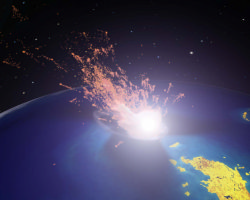This planet we call Earth is no stranger to catastrophic events. Four-and-a-half billion years ago, a young Earth and a Mars-sized wandering body violently collided, leaving behind orbiting debris that coalesced to become our Moon. Sixty-five million years ago, an immense meteorite crashed into the earth, generating a cloud of dust that obscured the sun and cooled the climate, resulting in the mass extinction of the dinosaurs.


Through January 31, 2008, the Einstein Planetarium at the Smithsonian National Air and Space Museum in Washington D.C. is featuring, “Cosmic Collisions,” a space show filled with stunning digital special effects that recreate our planet’s violent past.
Because these events happen on the scope of billions of years, mankind has not been witness to such catastrophic events, therefore the tendency is to believe that the universe is no longer a volatile place. Not so, purports “Cosmic Collisions.” The Andromeda Galaxy, closest neighbor to the Milky Way, is speeding toward us on a course that will, at worst, result in a head-on collision and at best, cause the two galaxies to scrape by one another at their outer edges. Scientists at NASA’s Hubble Space Telescope have created a spectacular scientific visualization of two galaxies colliding. The video, which has up to 23 times the resolution of a standard television, is projected across the planetarium dome and is wrapped 360 degrees around the audience, surrounding them in the experience.
Of course, this is expected to happen about five billion years from now, so I’m not losing sleep over it, but it does keep me humble. In the greater scope of things, I am truly insignificant.
